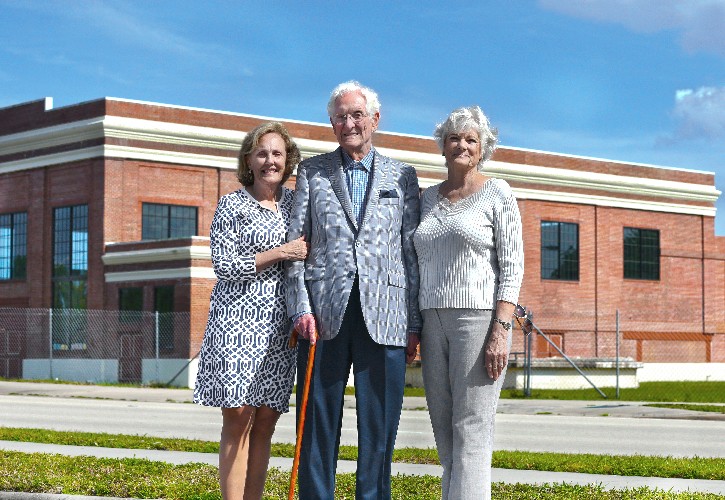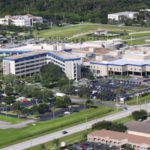
VERO BEACH — With the enthusiastic backing of beachside philanthropist Dick Stark, the Indian River Cultural Council is laying the groundwork for a campaign to acquire the historic diesel power plant in downtown Vero.
Hoping to turn it into an arts center similar to the Torpedo Factory Art Center in Alexandria, VA, the umbrella arts organization believes it can raise $4 million to renovate the shell of a building into 30 second-floor artists’ studios, with a restaurant downstairs.
Even though 2,000 people have signed petitions supporting the notion, at least two nearby gallery owners are calling the plan “a dream” and “pie-in-the-sky.”
Currently the plant, owned by the city of Vero Beach, isn’t even available: it’s tied up in a suit and countersuit between the city and the plant’s current tenants, developers David Croom, his son Charles Croom, and Phil Barth. Barth and another investor got a 45-year lease from the city in 2001; the Crooms joined in shortly afterwards.
If the suits are resolved in a way that frees the city from its lease, City Manager Jim O’Connor advocates selling the plant and says he’ll ask for written proposals for purchase to present to the city council.
A cash offer made last October still stands, says Guy d‘Amico, who wants to put a micro-distillery in the space. A former Pt. St Lucie resident who now lives in Coral Springs, he is building a home near Ambersand Beach.
In October, the d’Amicos wrote to the city with a cash offer of $595,000 for the shell of a building that still houses a huge diesel engine, one of three that once generated electricity. The building, dating to 1926, was placed on the National Historic Register in 1999 and was recently appraised at $500,000.
The red brick structure stands along State Road 60 downtown, some 50 yards west of the railroad tracks. O’Connor says it is the “closest large downtown building” to be impacted by the proposed All Aboard Florida high speed passenger trains. Those commuter trains are expected to pass through Vero more than 30 times daily by early 2016.
Opponents of the train have seized on the art center concept as another reason to resist the rapid rail plan, claiming the noise would disrupt the creative process.
“We are very concerned for our downtown,” says O’Connor, though he added, “I suppose tenants could make the building soundproof.”
D’Amico says the noise wouldn’t affect the production of his private-label liquor, which he will only describe as “clear” though he mentioned using Indian River citrus in the recipe.
The Cultural Council intends to lay out its plan next Wednesday at a meeting at the Heritage Center to the Indian River Neighborhood Association. Executive director Barbara Hoffman says the council “is a player” in any bid to acquire the property, should it become available.
But Stark is adamant that the city lease the building to the council at $1 a year, the arrangement enjoyed by Riverside Theatre and the Vero Beach Museum of Art for the land their buildings sit on in Riverside Park.
Stark is former chairman of the Cultural Council’s board of directors. His relentless efforts dating back to his 1978 arrival in John’s Island have furthered causes from the Vero Beach Museum of Art and Riverside Theatre to the Homeless Services Council.
During his tenure, the county cut funding to the council, and it did the same three years ago. He credits Hoffman with reviving the flagging organization that has seen its funding restored.
So far, all that remains of the developers’ substantial effort to resurrect the structure is a sign advertising it as available for lease. O’Connor said they originally sued the city for fraud for a three- to four-year delay in cleaning up environmental hazards at the site; the city countersued, claiming it was owed back rent.
The two sides are in the process of discovery, with depositions to follow before a judge decides the dispute.
Billy Moss of Lambert Commercial is still signed on to find tenants, an effort now in its fifth year. Moss calls the soaring 4,000 square foot space “majestic,” though much of the floor is still dirt. There is no plumbing or power.
If a second floor had to be added in order to create more rental spaces, it would likely have to be built on steel girders, d’Amico says.
Hoffman says the Cultural Council has not examined specifics of renovating. Architect Jeff Ray has generated blueprints, she says, and by the end of the year she expects to hire a national consultant to do a feasibility study.
Hoffman has already attracted some cultural heavy hitters to her cause. Among those on the arts center committee are Susan Grandpierre, Michael Rechter, Ross Power, Harry LaCava, Page Franzel, and Donna Lindsay.
One downtown gallery owner has doubts that the Cultural Council would be able to keep the building occupied, even if it managed to raise the capital to renovate the space.
“It’s not a terrible goal,” says George O’Malley, co-owner of Darby Gallery on 14th Avenue. “I just don’t know if it would work. Artists don’t make much money.”
He is also concerned that the corridor of galleries on 14th Avenue downtown, which has enjoyed a revival in the past five years with monthly strolls often drawing over 1,000 visitors, may have reached its saturation point.
Hoffman insists the spaces in the proposed art center will be studios, not galleries, though the works of the artists will be available for sale. Rent for the 100-square-foot studios would be in the $350 range, she estimates. Each artist would be required to spend a certain amount of hours per week at the center so that visitors will have something to see. She compared the concept to Fort Pierce’s Art Mundo cooperative, though that center is in a former bank building in far better shape than the diesel plant. She says she has met with the developer of that project. “They bought the book from the Torpedo Factory on how to do it,” she says.
She says the first phase of the project would involve outdoor activities with the installation of brightly colored “containers,” or pre-fab buildings, as well as portable toilets and an outdoor kitchen. She foresees creating an amphitheater for Shakespeare festivals and concerts.
“I can see us doing something like an Art Basel,” she says, referring to the huge international art sale in Miami.
Diana Stark says the arts center would be much more family-friendly than a distillery. “This is a place where you can go watch glass-blowing and have something to eat and make something at the festivals,” she says.
Stark, who celebrated his 93rd birthday last week, says the city shouldn’t be concerned that the arts center, a non-profit, would not generate tax revenue, as a business venture would. He repeated with vehemence what he says he told city officials: “It’s not about what this gives you, it’s about what you give them.”
The distillery, Stark says, would be “disastrous” for downtown, though he concedes with a grin, “I’d like to have a tipple.”
The informational meeting, scheduled for April 23 from 5 to 6:30 p.m., takes place at the Heritage Center on 14th Avenue.





